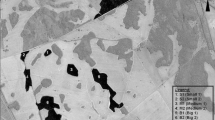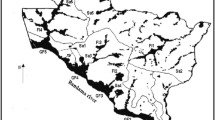Abstract
Maculinea butterflies obligatory parasitize certain species of Myrmica ants. Thus, the presence of the host ant species is a limiting factor for the survival of a Maculinea population. Here, we analyse the influence of vegetation structure and ground temperature on ant diversity and abundance on Maculinea habitats, with the final aim of identifying the environmental variables determining patterns of variation in species composition in order to recommend a mowing regime that will promote our three target species: Maculinea teleius, M. nausithous and M. alcon. Experimental plots with different mowing regimes were established at eight sites in South-Eastern Germany, a region which still contains a number of relatively large, stable populations of these threatened butterfly species. Among the seven different ant species recorded, four belong to the genus Myrmica (M. scabrinodis, M. rubra, M. ruginodis and M. vandeli). Among these, M. scabrinodis results most abundant at all sites. In a CCA analysis of environmental variables recorded at the studied plots, ant species diversity appears largely determined by litter cover, mean temperature, and mean grass cover. Mowing once a year, in the second half of September, after the larvae have left their host plants, enhances the abundance of Myrmica ants in the meadows, and would be the best management compromise for all three species.






Similar content being viewed by others
References
Als TD, Vila R, Kandul NP, Nash DR, Yen S-H, Hsu Y-F, Mignault AA, Boomsma JJ, Pierce NE (2004) The evolution of alternative parasitic life histories in large blue butterflies. Nature 432:386–389
Andersen AN (1995) A classification of Australian ant communities, based on functional groups which parallels plant life-forms in relation to stress and disturbance. J Biogeogr 22:15–29
Armbrecht I, Rivera L, Perfecto I (2005) Reduced diversity and complexity in the leaf-litter ant assemblage of Colombian coffee plantations. Conserv Biol 19:897–907
Beck J, Schulze CH, Linsenmair KE, Fiedler K (2002) From forest to farmland: diversity of geometrid moths along two habitat gradients on Borneo. J Trop Ecol 18:33–51
Bergman K-O, Askling J, Ekberg O, Ignell H, Wahlman H, Milberg P (2004) Landscape effects on butterfly assemblages in an agricultural region. Ecography 27:619–628
Cattin M-F, Blandenier G, Banašek-Richter C, Bersier L-F (2003) The impact of mowing as a management strategy for wet meadows on spider (Araneae) communities. Biological Conservation 113:179–188
Czechowski W, Radchenko A, Czechowska W (2002) The ants (Hymenoptera, Formicidae). Museum and Institute of Zoology PAS, Warszawa
Dauber J, Wolters V (2004) Edge effects on ant community structure and species richness in an agricultural landscape. Biodivers Conserv 13:901–915
Dauber J, Wolters V (2005) Colonization of temperate grassland by ants. Basic Appl Ecol 6:83–91
Dauber J, Bengtsson J, Lenoir L (2005) Evaluating effects of habitat loss and land-use continuity on ant species richness in seminatural grassland remnants. Conserv Biol 20:1150–1160
Elmes GW, Thomas JA (1992) Complexity of species conservation in managed habitats—interaction between Maculinea butterflies and their ant hosts. Biodivers Conserv 1:155–169
Erhardt A (1985) Diurnal Lepidoptera: sensitive indicators of cultivated and abandoned grassland. J Appl Ecol 22:849–861
Fedoseeva EB, Demchenko AV (1997) Effects of substrate on nest density in ants Myrmica ruginodis (Hymenoptera, Formicidae). Zoologichesky Zhurnal 76:543–553 (in Russian)
Gallé L (1986) Habitat and niche analysis of grassland ants (Hymenoptera: Formicidae). Entomol Gen 11:197–211
Glinka U, Settele J (2005) The effect of ant communities and spatial pattern for Maculinea nausithous. In: Settele J, Kühn E, Thomas JA (eds) Butterfly ecology along a European transect: Maculinea as a case study. Pensoft, Sofia, p 72
Grill A, Cleary DFR (2003) Diversity patterns in butterfly communities of the Greek nature reserve Dadia. Biol Conserv 114:427–436
Holec M, Frouz J (2005) Ant (Hymenoptera: Formicidae) communities in reclaimed and unreclaimed brown coal mining spoil dumps in the Czech Republic. Pedobiologia 49:345–357
IUCN (World Conservation Union) (1990) Red list of threatened animals. World Conservation Monitoring Centre, Cambridge, UK
Johst K, Drechsler M, Thomas JA, Settele J (2006) Influence of mowing on the persistence of two endangered large blue butterfly species. J Appl Ecol 43:333–342
Kaspari M, Ward PS, Yuan M (2004) Energy gradients and the geographic distribution of local ant diversity. Oecologia 140:407–413
Kati V, Dufrêne M, Legakis A, Grill A, Philippe L (2004) Conservation management for Orthoptera in the Dadia reserve, Greece. Biol Conserv 115:33–44
Maes D, Van Dyck H, Vanreusel W, Cortens J (2003) Ant communities (Hymenoptera: Formicidae) of Flemish (north Belgium) wet heathlands, a declining habitat in Europe. Eur J Entom 100:545–555
Maes D, Vanreusel W, Talloen W, Van Dyck H (2004) Functional conservation units for the endangered Alcon Blue butterfly Maculinea alcon in Belgium (Lepidoptera: Lycaenidae). Biol Conserv 120:233–245
McGarigal K, Cushman S, Stafford S (2000) Multivariate statistics for wildlife and ecology research. Springer, New York
Morris MG (2000) The effects of structure and its dynamics on the ecology and conservation of arthropods in British grasslands. Biol Conserv 95:129–142
Mouquet N, Belrose V, Thomas JA, Elmes GW, Clarke RT, Hochberg ME (2005) Conserving community modules: a case study of the endangered Lycaenid butterfly Maculinea alcon. Ecology 86:3160–3173
Munguira ML, Martin J (1999) Action plan for the Maculinea butterflies in Europe. Nature and Environment No. 97. Council of Europe, Strasbourg
Öckinger E, Hammarstedt O, Nilsson SG, Smith HG (2006) The relationship between local extinctions of grassland butterflies and increased soil nitrogen levels. Biol Conserv 128:564–573
Quinger B, Schwab U, Ringler A, Bräu M, Strohwasser R, Weber J (1995) Lebensraumtyp Streuwiesen. In: Bayerisches StMLU, ANL (eds) Landschaftspflegekonzept Bayern, Band II. 9. Alpeninstiut GmbH, Bremen, München
Retana J, Cerda X (2000) Patterns of diversity and composition of Mediterranean ground ant communities tracking spatial and temporal variability in the thermal environment. Oecologia 123:436–444
Seifert B (1996) Ameisen: beobachten, bestimmen. Naturbuch-Verlag, Augsburg
Seifert B (2004) The “Black Bog Ant” Formica picea NYLANDER, 1846—a species different from Formica candida SMITH, 1878 (Hymenoptera: Formicidae). Myrmecologische Nachr 6:29–38
Settele J, Thomas JA, Boomsma JJ, Kühn E, Nash D, Anton C, Woyciechowski M, Varga Z (2002) MACulinea butterflies of the habitats directive and European red list as indicators and tools for conservation and MANagment (MacMan). Verh Ges Ökologie 32:63
Siegel S, Castellan NJ (1988) Nonparametric statistics for the behavioral sciences, 2nd edn. McGraw-Hill, New York
Steiner FM, Schlick-Steiner BC (2002) Einsatz von Ameisen in der naturschutzfachlichen Praxis. Naturschutz Landschaftsplanung 34:5–12
Stettmer C, Binzenhöfer B, Hartmann P (2001a) Habitatmanagement und Schutzmaβnahmen für die Ameisenbläulinge Glaucopsyche teleius und Glaucopsyche nausithous—Part 1: Populationsdynamik, Ausbreitungsverhalten und Biotopverbund. Natur Landsch 76:278–287
Stettmer C, Binzenhöfer B, Gros P, Hartmann P (2001b) Habitatmanagement und Schutzmaβnahmen für die Ameisenbläulinge Glaucopsyche teleius und Glaucopsyche nausithous—Part 2: Habitatansprüche, Gefährdung und Pflege. Natur Landsch 76:366–375
Teixeira MC, Schoereder JH, Nascimento JT, Louzada JNC (2005) Response of ant communities to sand dune vegetation burning in brazil (Hymenoptera: Formicidae). Sociobiology 45:631–641
Ter Braak CJF (1986) Canonical correspondence analysis: a new eigenvector technique for multivariate direct gradient analysis. Ecology 67:1167–1179
Ter Braak CJF, Smilauer P (1998) CANOCO 4. Microcomputer Power, Ithaca, NY, USA
Ter Braak CJF, Verdonschot PF (1995) Canonical correspondence analysis and related multivariate methods in aquatic ecology. Aquat Sci 57:255–289
Theunis L, Gilbert M, Roisin Y, Leponce M (2005) Spatial structure of litter-dwelling ant distribution in a subtropical dry forest. Insect Soc 52:366–377
Thomas JA, Wardlaw JC (1992) The capacity of a Myrmica ant nest to support a predacious species of a Maculinea butterfly. Oecologia 91:101–109
Thomas JA, Settele J (2004) Butterfly mimics of ants. Nature 432:283–284
Van Swaay CAM, Warren MS (1999) Red data book of European butterflies (Rhopalocera). Nature and Environment, No. 99, Council of Europe Publishing, Strasbourg
Witek M, Skorka P, Sliwinska E, Nowicki P, Woyciechowski M (2005) The ant communities of meadows in the Krakow region. In: Settele J, Kühn E, Thomas JA (eds) Butterfly ecology along a European transect: Maculinea as a case study. Pensoft, Sofia, p 51
Wynhoff I (1998) The recent distribution of the European Maculinea species. J Insect Conserv 2:15–27
Acknowledgements
We thank the EU Framework V RTD project ‘MacMan’ (EVK2-CT-2001-00126; Settele et al. 2002) and the Bavarian Academy for Nature Conservation and Landscape planning (ANL) for research grants. Anonymous referees of previous submissions gave valuable hints to improve the manuscript.
Author information
Authors and Affiliations
Corresponding author
Rights and permissions
About this article
Cite this article
Grill, A., Cleary, D.F.R., Stettmer, C. et al. A mowing experiment to evaluate the influence of management on the activity of host ants of Maculinea butterflies. J Insect Conserv 12, 617–627 (2008). https://doi.org/10.1007/s10841-007-9098-1
Received:
Accepted:
Published:
Issue Date:
DOI: https://doi.org/10.1007/s10841-007-9098-1




